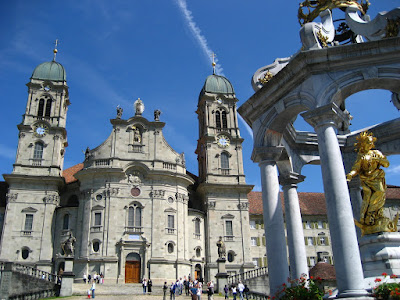In addition to all the meetings, tours, explanations, and evaluations that are an expected part of any orientation, the orientation team has also put together some pretty neat activities and excursions to help our class of 61 grow in fraternity and also to introduce us to Rome and its many spiritual riches. Thursday, for example, was the feast of St. Augustine, the great bishop and Doctor of the Church, and we were given the opportunity to visit his namesake church here in Rome. The church contains the tomb of St. Monica, Augustine's mother and a key instrument in his conversion, and we took the opportunity to pray for our own mothers and all those that have helped form us in our faith. On Friday, the NAC arranged us for us to have Mass in the crypt of St. Peter's Basilica and next to the tomb of Saint Peter himself. About half of the 265 popes are interred somewhere in the basilica, with many of the more recent ones in the crypt near St. Peter, including John Paul II and Paul VI. It was quite moving to be so close to the men that have for two millennia guided our Church, the Church for which I am now studying and preparing to serve as a priest. It was, er, quite the motivational moment.
Today, though, was certainly the best experience thus far. We were able to attend the Sunday address and Angelus with Pope Benedict at his summer villa in Castel Gandolfo, located only about 15 miles southeast of Rome on Lake Albano. The papal residence dates from the 17th century and has traditionally been used by popes as a break from the stresses and heat of Rome in the months of July, August, and September. It also is the location of some 140 acres of Vatican gardens and farms, land that was appropriated to the Holy See as part of the Lateran Accords in 1929.
Arriving in Castel Gandolfo mid-morning, our group was ushered through some backdoors until we arrived at a side entrance to the courtyard from which the Pope makes his Sunday address. The courtyard is not very large -- perhaps 50 yards square -- but hundreds were able to pack in, including groups from Germany, Spain, Brazil, France, and a bunch of nuns from Poland. We waited in the square about an hour, and the atmosphere was, as you might expect, quite dynamic, with flag-waving, song-singing, picture-taking, and extended chants of "Benedetto!" filling the time.
 Waiting ...
Waiting ...At noon, the Pope appeared and delivered a reflection on the Gospel of the day, assuring us that suffering must be a part of the life of every Christian -- not for its own sake, however, but as a means by which we come to share in the Resurrection of Christ. His Holiness also remarked on the modern problem of immigration, noting especially the recent tragedy in Malta. After his remarks, we joined him in praying the Angelus, and he then greeted the various groups gathered below him in their native tongues. After speaking in English, those of us from the NAC sang "Ad Multos Annos" ("May you live for many years") which is apparently a kind of fight song for the school and was, of course, appropriate for the occasion.
After the Pope retired to his villa, we had lunch at a restaurant overlooking Lake Albano, and then were treated to a tour of the papal gardens. Archbishop James Harvey, Prefect of the Papal Household, is an American from Milwaukee and has always been very generous to the students of the NAC in allowing us access to these gardens, usually visited only by visiting heads of state and other guests and by the Pope himself. Archbishop Harvey proceeded to give us a personal tour of the gardens. Occupying a relatively narrow but long piece of land, they were built on the site of what used to be a private villa of the emperor Domitian, and there remain many ruins in the garden, most notably a long gallery that was used as a sort of promenade in imperial times. In more recent years, Pope Pius XII used it to hide thousands of Jews when the Germans moved into Lazio.
Archbishop Harvey was a delight to listen to and shared many interesting and moving stories about the customs and habits of the two most recent popes. I'll share two. First, he mentioned that John Paul II used to enjoy the gardens very much, especially the swimming pool which he would frequent at least twice a day in the early part of his papacy. Even as his health began to deteriorate, he still would trek out into the gardens using a cane. In the last year of his life, although he was now being driven around the gardens, he still visited a Marian shrine every day where he would sing, alone, a traditional Polish hymn to Our Lady.
 The Marian shrine that Pope John Paul II prayed at each day and where Benedict prays his rosary today.
The Marian shrine that Pope John Paul II prayed at each day and where Benedict prays his rosary today.
It was a great day, and one of those rare and powerful experiences that only being in Rome can provide. Life here certainly has its challenges, many of which I've learned in the few short weeks I've been here, but it's days like today that make one truly grateful to be given this opportunity. Not to mention that, like with the tomb of St. Peter, it's reassuring for one's vocation when you see the Pope smiling down at you.
Happy Labor Day to all of you in the States. We're celebrating it here by starting the second round of Italian classes tomorrow. And I'm sure you're already quite aware, but be sure to keep all those folks down in the Gulf in your prayers as Gustav sounds like it could be quite the storm.




















